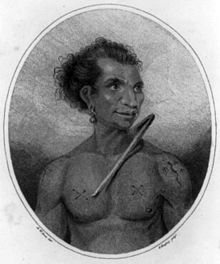
Abba Thulle[a] was the ibedul, 'paramount chief'[b] of Koror whom the sailor Henry Wilson and his crew met on their voyage to Palau in 1783.[1][2] His second son Prince Lee Boo became one of the first people from the Pacific Islands to visit Great Britain, but died six months after he departed.[3] He learned of his son's death when Captain John McCluer later visited the islands.[4] Andrew Cheyne wrote about his encounter with Abba Thulle in the book A description of islands in the western Pacific ocean, north and south of the equator.[5] William Lisle Bowles wrote a poem about him entitled Abba Thule's Lament For His Son Prince Le Boo.[6] A horse was named after him that later won the Doncaster Cup in 1790.[7]
Notes
[edit]References
[edit]- ^ "Ibedul". The British Museum. Archived from the original on 30 December 2023. Retrieved 12 July 2021.
- ^ "Capt Henry Wilson". The British Museum. Archived from the original on 30 December 2023. Retrieved 30 December 2023.
- ^ "Prince Lee Boo, second son of Abba Thule [picture]". National Library of Australia. Retrieved 13 July 2021.
- ^ Goetzfridt, Nicholas J.; Peacock, Karen M. (2002). Micronesian Histories: An Analytical Bibliography and Guide to Interpretations. ISBN 9780313291036. Retrieved 13 July 2021.
- ^ Cheyne, Andrew (1852). "A description of islands in the western Pacific ocean, north and south of the equator". Google Books. Retrieved 13 July 2021.
- ^ "ABBA THULE'S LAMENT FOR HIS SON PRINCE LE BOO". Project Gutenberg. Retrieved 13 July 2021.
- ^ "Doncaster Cup Winners". tbheritage. Retrieved 13 July 2021.
Well, that’s interesting to know that Psilotum nudum are known as whisk ferns. Psilotum nudum is the commoner species of the two. While the P. flaccidum is a rare species and is found in the tropical islands. Both the species are usually epiphytic in habit and grow upon tree ferns. These species may also be terrestrial and grow in humus or in the crevices of the rocks.
View the detailed Guide of Psilotum nudum: Detailed Study Of Psilotum Nudum (Whisk Fern), Classification, Anatomy, Reproduction